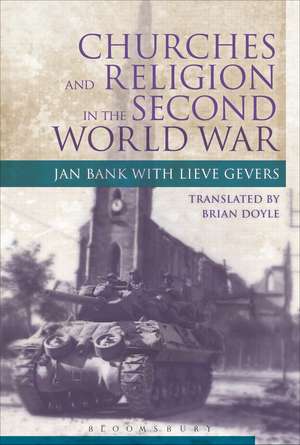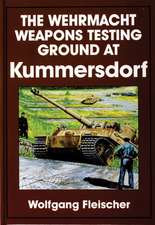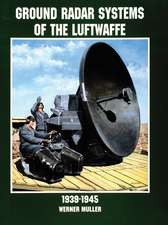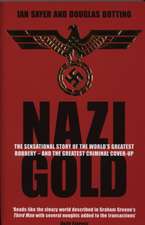Churches and Religion in the Second World War: Occupation in Europe
Autor Jan Bank, Lieve Geversen Limba Engleză Paperback – 23 mar 2016
| Toate formatele și edițiile | Preț | Express |
|---|---|---|
| Paperback (1) | 190.22 lei 3-5 săpt. | |
| Bloomsbury Publishing – 23 mar 2016 | 190.22 lei 3-5 săpt. | |
| Hardback (1) | 724.70 lei 6-8 săpt. | |
| Bloomsbury Publishing – 23 mar 2016 | 724.70 lei 6-8 săpt. |
Preț: 190.22 lei
Preț vechi: 214.62 lei
-11% Nou
Puncte Express: 285
Preț estimativ în valută:
36.40€ • 38.10$ • 30.30£
36.40€ • 38.10$ • 30.30£
Carte disponibilă
Livrare economică 10-24 martie
Preluare comenzi: 021 569.72.76
Specificații
ISBN-13: 9781845208226
ISBN-10: 1845208226
Pagini: 624
Ilustrații: 20 bw illus
Dimensiuni: 156 x 234 x 33 mm
Greutate: 0.93 kg
Ediția:New.
Editura: Bloomsbury Publishing
Colecția Bloomsbury Academic
Seria Occupation in Europe
Locul publicării:London, United Kingdom
ISBN-10: 1845208226
Pagini: 624
Ilustrații: 20 bw illus
Dimensiuni: 156 x 234 x 33 mm
Greutate: 0.93 kg
Ediția:New.
Editura: Bloomsbury Publishing
Colecția Bloomsbury Academic
Seria Occupation in Europe
Locul publicării:London, United Kingdom
Caracteristici
Despite the wealth of historical studies on this period, this is the first comprehensive study of Christianity in Europe during the Second World War
Notă biografică
Jan Bank is Emeritus Professor of Dutch History at the University of Leiden, the Netherlands.Lieve Gevers is Emeritus Professor of the History of the Church and Theology at the Catholic University, Leuven, Belgium.
Cuprins
IntroductionChapter 1: Church and State, Church and Nation after the First World WarChapter 2: Churches and Totalitarian IdeologiesChapter 3: Churches in Occupied Territories in the InterbellumChapter 4: Religion in All Out WarChapter 5: Churches between Loyalty and ResistanceChapter 6: The Nazi Mass Murder and the ChurchesChapter 7: The Pope, the Patriarch and the Oecumenical CouncilConclusion
Recenzii
Never before has a volume provided a synoptic narrative of church activities across the continent, from France to the Soviet Union, during the war years. With erudition and sensitivity, Bank and Gevers tell the stories of the many churches scattered across Europe, and how they mobilized the Christian message of peace, or failed to, in an era of total war.
This massive study surveys the secondary literature to develop a portrait of how the Christian churches of occupied Europe responded to one of the most brutal episodes in human history. The authors focus on how the Christian churches in the "totalitarian zone"-Nazi-, Fascist-, and Soviet-controlled territory-experienced the period 1919-1945. How did the churches interact with these regimes? To what extent did their role as "bulwarks" of the nation influence their reaction to total war? Central to the volume is the churches' response to genocide. The result is a balanced account. The secondary literature the authors surveyed includes both accusatory and exculpatory assessments of the role of the major Christian churches (Roman Catholic, Eastern Orthodox, and Protestant) in both Nazi and Soviet atrocities. Two common themes emerge: the churches' first priority was to protect their own members; the fear that speaking out would only worsen the situation. .[T]he work will serve as a solid compendium of information on the Christian response to the greatest challenge the faith has faced since the Edict of Toleration. For history and religious studies collections. Summing Up: Highly recommended. All academic levels/libraries.
[The authors] provide a broad overview of the position of churches and Christians during the Second World War ... They work with a truly interdenominational and international perspective. (Bloomsbury translation)
Because this book is the first to provide a general history of the churches during World War II and is so comprehensive and generally reliable in its selection and interpretation, it is an essential book for church historians, historians of World War II, and academic libraries.
This important book provided the first genuinely Europe-wide account of the actions of the European Christian churches during the Second World War. It is essential reading for understanding the war, but also the role that the churches have played in twentieth-century European history.
Jan Bank and Lieve Gievers have provided a valuable summary of the secondary literature about the role of religion and churches during World War II. Anti-Semitism already pervaded both Catholic and Protestant theology, but the virtual identification of religion and nationalism led to violent anti-Semitism and even the "Final Solution." In Germany, there arose a form of idolatry of the state and its leader, Hitler. In Eastern Europe, Josef Stalin appealed to Russian nationalism by removing restrictions on the Russian Orthodox Church. His ultimate plan was to subsume all branches of the Orthodox Church in Eastern Europe under Moscow and create a second Vatican. But to be Russian and Orthodox meant also to be anti-Semitic. The authors also note postwar continuity with wartime activity, such as ecumenism in the Netherlands stemming from the cooperation between the Dutch bishops and their Protestant counterparts and growing attention to the United States.
This massive study surveys the secondary literature to develop a portrait of how the Christian churches of occupied Europe responded to one of the most brutal episodes in human history. The authors focus on how the Christian churches in the "totalitarian zone"-Nazi-, Fascist-, and Soviet-controlled territory-experienced the period 1919-1945. How did the churches interact with these regimes? To what extent did their role as "bulwarks" of the nation influence their reaction to total war? Central to the volume is the churches' response to genocide. The result is a balanced account. The secondary literature the authors surveyed includes both accusatory and exculpatory assessments of the role of the major Christian churches (Roman Catholic, Eastern Orthodox, and Protestant) in both Nazi and Soviet atrocities. Two common themes emerge: the churches' first priority was to protect their own members; the fear that speaking out would only worsen the situation. .[T]he work will serve as a solid compendium of information on the Christian response to the greatest challenge the faith has faced since the Edict of Toleration. For history and religious studies collections. Summing Up: Highly recommended. All academic levels/libraries.
[The authors] provide a broad overview of the position of churches and Christians during the Second World War ... They work with a truly interdenominational and international perspective. (Bloomsbury translation)
Because this book is the first to provide a general history of the churches during World War II and is so comprehensive and generally reliable in its selection and interpretation, it is an essential book for church historians, historians of World War II, and academic libraries.
This important book provided the first genuinely Europe-wide account of the actions of the European Christian churches during the Second World War. It is essential reading for understanding the war, but also the role that the churches have played in twentieth-century European history.
Jan Bank and Lieve Gievers have provided a valuable summary of the secondary literature about the role of religion and churches during World War II. Anti-Semitism already pervaded both Catholic and Protestant theology, but the virtual identification of religion and nationalism led to violent anti-Semitism and even the "Final Solution." In Germany, there arose a form of idolatry of the state and its leader, Hitler. In Eastern Europe, Josef Stalin appealed to Russian nationalism by removing restrictions on the Russian Orthodox Church. His ultimate plan was to subsume all branches of the Orthodox Church in Eastern Europe under Moscow and create a second Vatican. But to be Russian and Orthodox meant also to be anti-Semitic. The authors also note postwar continuity with wartime activity, such as ecumenism in the Netherlands stemming from the cooperation between the Dutch bishops and their Protestant counterparts and growing attention to the United States.
Descriere
A study of Christian religions and churches in Europe at the time of the Second World War.

















